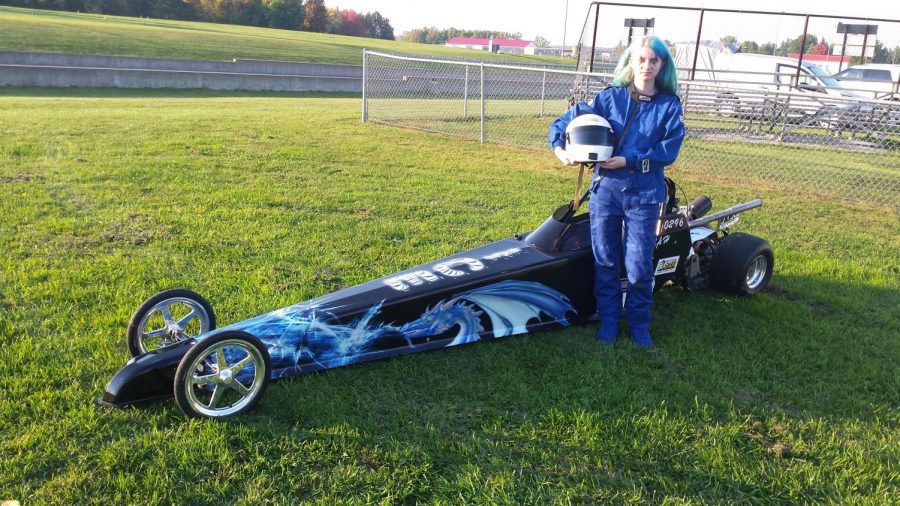Student participates in drag racing motorsport
Mitschke poses with her dragster.
With wheels of steel, a roaring engine, and a car that spits bursts of flames, senior Sarah Mitschke flies down the track. Turning corners and staying in her lane while trying to be the best in her division, it is not an easy task.
Mitschke, also known as “Ice” on the race track, is a senior who has drag raced since she was nine years old. Racing is something she has grown up with; her father and mother were both racers. Mitschke first started for fun and did not start racing competitively until she was ten. Mitschke commented on why she decided that drag racing was what she wanted to do.
“I don’t work well on a team, but when you’re racing it’s just you and the car and that’s it,” Mitschke said.
When people would ask her what she wanted to be when she was little, there was no typical answer of doctor, firefighter or fairy princess; she only wanted to be a racer.
“I started [racing] because I wanted to do something that was me, ever since kindergarten I wanted to be a race car driver, and that’s what I ended up becoming,” Mitschke said.
Going into the sport, she felt she was not ready to start competitively racing. She was a second generation racer, meaning her parents both raced before her. She races against third-generation racers who come from families where their grandparents and parents raced before them. Mitschke commented on what it was like to start racing.
“A lot of people saw me as an underdog, and I felt like that, too. That was a new experience, which I was definitely not used to,” Mitschke said.
While Mitschke is the oldest in her family, she also has a younger sister, Jesse, who is in the eighth grade. Jesse has been racing for about five years and commented on why she started.
“My parents raced then my [sister] started racing and I thought it was really cool so I asked my dad if I could race like Sarah and he said yes,” she said.
Having a sibling or a parent in the game helps, too, as they can act as mentors to the racer. Mitschke commented on how her older sister has helped her through the years.
“When my [sister] got the hang of it she started to help me a little bit but it was mostly my dad who made the whole thing,” Jesse said.
Like her sister, Mitschke loves the feeling of going down the track at a fast pace. Mitschke commented on what it is like to race.
“The best part [about racing] is being able to go super fast, 80 mph to be exact,” Mitschke said.
Many people race for different reasons, Mitschke explained why she started racing.
“For me its all for fun, in a way it did turn into something more, for me it’s kind of like having a split personality. In school you could be the most stressed out person but when you go to the race track all of your cares just [float] away. All you care about is the race. I stuck with it because for me it took the stress away,” Mitschke said.
Sarah has raced many different cars. She started with her first car when her father saw it for sale and decided to purchase it for her. Sarah commented on her very first car.
I had this car. We call it Jurassic Car because it was a piece of junk tin can that we fixed up. The first time I raced it, the carburetor blew off, and I never even made it to the 60 mark, which was kind of embarrassing,” she said.
Sarah has raced many cars over the years, including a 1967 gold Camaro Convertible, her father’s 1971 Monte Carlo SS and her mother’s 2017 Impala. Her current drag racing car is a 2001 Half Scale Junior Dragster.
Mitschke explained that racing feels normal to her. She commented on how when she gets in the car, it feels like muscle memory, and she completes the race.
“Going down the track is interesting because the whole world flies by you, you’re in your own little time zone, it feels like a dream, it’s amazing… It’s become second nature, just because I get in the car and I just do what I have to do,” Mitschke said.
Mitschke explained some of the many rules racers must follow to qualify for races.
“One thing is that you can’t horse around in the pit area, you get kicked off for that.
We have to have our seatbelts on, helmets on, two functioning kill switches, one inside, and one outside for the crew chief. With breaking out in speed, you can’t go faster than 85 miles per hour. For all classes you can’t take off before the green light,” Mitschke said.
Sometimes the car can not race by the rules, especially when the weather is acting up. This can affect the race too if the conditions are not stable, the racers are unable to complete the track due to safety issues. Mitschke commented on how weather affects racing.
“Temperature has a huge effect on the engines. I had my car setup for 7.6 [seconds] but it ran 9.0 [seconds] due to being extremely muggy… We can be anything as long as it is not raining or snowing, or super windy. I was in this race where the wind was absolutely insane, I almost ran into another car, it was so hard to keep my car straight,” Mitschke said.
The weather is just one factor in what tells the racers if they can race or not; it also depends on the season. Once it gets colder and snowy, the thrill seekers are forced to stop racing until the conditions clear up. Mitschke commented on the racing season.
“[We race] usually from spring to fall, when the snow starts falling it’s pretty much done,” Mitschke said.
Sarah is aging out of her legal racing age after next summer. She will no longer be in the junior category. If she is lucky, she will be able to have a sponsor take care of her car while she is racing it, but she thinks she just wants to do it as a side hobby.
While she has had many amazing races and met some of her good friends, she does not think she will pursue auto mechanics at the college of her choice. Instead, she would much rather design video games or learn about computer programming.

